
About UsThe Numismatic Bibliomania Society is a non-profit organization promoting numismatic literature. For more information please see our web site at coinbooks.org SubscriptionsThose wishing to become new E-Sylum subscribers (or wishing to Unsubscribe) can go to the following web page link MembershipThere is a membership application available on the web site Membership Application To join, print the application and return it with your check to the address printed on the application. Membership is only $15 to addresses in the U.S., $20 for First Class mail, and $25 elsewhere. For those without web access, write to: David M. Sundman, Secretary/TreasurerNumismatic Bibliomania
Society AsylumFor Asylum mailing address changes and other membership questions, contact David at this email address: dsundman@LittletonCoin.com SubmissionsTo submit items for publication in The E-Sylum, just Reply to this message, or write to the Editor at this address: whomren@coinlibrary.com
BUY THE BOOK BEFORE THE COINYou won't regret it! |
- WAYNE'S WORDS: THE E-SYLUM OCTOBER 11, 2009
- 2010 NBS MEETING TO BE HELD AT MASSACHUSETTS HISTORICAL SOCIETY
- NEW BOOKS: KRAUSE PUBLICATIONS' U.S. PAPER MONEY GUIDES
- NEW BOOK: 2010 PHILADELPHIA EXPO RED BOOK
- BOOK REVIEW: OVERSTRUCK GREEK COINS BY DAVID MACDONALD
- BOOK REVIEW: WHITMAN ENCYCLOPEDIA OF U. S. PAPER MONEY
- MORE ON THE PROFESSIONAL EDITION RED BOOK
- AMERICAN NUMISMATIC SOCIETY PUBLICATION HISTORY
- DICK JOHNSON: LAUNCHING A NEW MEDAL AND A NEW BUSINESS
- NOVA CONSTELLATIO PATTERN SET SURFACES IN PHILADELPHIA
- 2010 BRITISH-AMERICAN TOKEN CONGRESS
- COINTELEVISION.COM ANNOUNCES NEW WEBSITE DESIGN
- NOTES AND COMMENTS ON LAST WEEK'S ISSUE
- MORE ON NUMISMATICS AND SHERLOCK HOLMES
- MORE ON ALCOHOLICS ANONYMOUS TOKENS
- FORMER ANA EXECUTIVE DIRECTOR KEEPS LAW LICENSE
- CONTRIBUTIONS OF ALCHEMY TO NUMISMATICS
- CONTEMPORARY THOUGHTS ON THE 1878 GOLOID DOLLAR PROPOSAL
- COINS FOR HARD TIMES: ARTIST MAKES HIS OWN MONEY
- SERGEY BRIN DEFENDS GOOGLE BOOKS
- WASHINGTON POST CLIPPINGS ON VARIOUS TOPICS
- POLYMER BANKNOTE FIRM CHARGED WITH BRIBING OFFICIALS
- ARTICLE: COIN HOARDS HOLD CLUES TO ANCIENT ROMAN POPULATION
- GOLD COIN HOARD PRACTICAL JOKER STRIKES FROM THE GRAVE
- DOLLAR BILL GRAFFITI
- FEATURED WEB PAGE: HISTORY OF HOBO NICKELS
WAYNE'S WORDS: THE E-SYLUM OCTOBER 11, 2009

Among our recent subscribers is C. M. Sundar of India. Welcome aboard! We now have 1,267 subscribers.
This week we open with some NBS news followed by announcements of new books on U.S. paper money and a special edition of the 2010 Redbook. Next up is my review of David MacDonald's Overstruck Greek Coins and John and Nancy Wilson's review of the Whitman Encyclopedia of U. S. Paper Money.
The big news this week (to me, anyway) was the appearance of the Nova Constellatio pattern set at the recent Whitman Philadelphia show - we have an admittedly lengthy piece about the set with contributions from several readers.
In other news, Dick Johnson launches a new medal business, the 2nd Annual British-American Token Congress has been scheduled, and the results of the law license suspension hearing for the former Executive Director of the ANA have been made public.
To learn about the thirty-year practical joke, alchemy and numismatics, and which coin is like "tying a bull pup to a basket of cucumbers", read on.
Wayne Homren
Numismatic Bibliomania Society
2010 NBS MEETING TO BE HELD AT MASSACHUSETTS HISTORICAL SOCIETY
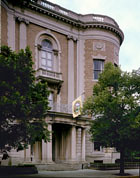 Numismatic Bibliomania Society President Dan Hamelberg reports:
Numismatic Bibliomania Society President Dan Hamelberg reports:
We have secured a room in the Massachusetts Historical Society for our regular NBS meeting at the American Numismatic Association convention next year in Boston. It should be a great environment for our meeting, and we will have the opportunity to look thru some of their holdings as well.
For more information on the Massachusetts Historical Society, see: www.masshist.org
NEW BOOKS: KRAUSE PUBLICATIONS' U.S. PAPER MONEY GUIDES
Large or small, Krause Publications has U.S. paper money collecting covered with the recent arrival of two new books.
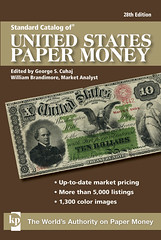
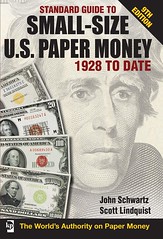
The new edition of Standard Catalog of United States Paper Money and Standard Guide to Small-Size U.S. Paper Money are both available, and bring to the table more pricing, color photographs and listings of notes than ever before. A perfect pair, together these two guides represent the most thorough information about U.S. paper money available today.
This 28th edition of the Standard Catalog of United States Paper Money is written by noted collector and author George S. Cuhaj with market analysis by William Brandimore, contains details about nearly 200 year of U.S. currency, and features notes in full-color photographs. This book is a superior introduction to the world of U.S. paper money, with coverage of everything from large and small-size currency, silver and gold certificates and Pre-Civil War treasury notes, to fractional currency and military payment certificates.
With listings of paper money dating back to 1812 through recent issues and current market value in up to four condition grades, this book's organization, larger-size listings and design make it easy to use and comprehensive in scope.
Also making a spectacular return is Standard Guide to Small-Size U.S. Paper Money back, now with full-color photographs as well. The color photos make it easier to identify the differences between similar notes, and even notes of the same series. For example, the difference between a dark forest green, light yellow green and dark blue green United States Treasury Seal is an important detail for properly identifying the note and determining value, and with this book these intricate difference are more easy to see.
In addition, this ninth edition of the Standard Guide to Small-Size U.S. Paper Money contains current market values in up to four grades of condition, serial number data for notes from 1928 to 2006, and precise quantities of notes printed or observed.
Click here for more information about the books at ShopNumisMaster.com
About the Authors
Standard Catalog of United States Paper Money author George S. Cuhaj is an experienced and accomplished collector and researcher. He is the editor of both the Standard Catalog of World Paper Money and Standard Catalog of World Coins series, and has been part of the Krause Publications Numismatic division since 1994. Market analyst William Brandimore has been collecting paper money for more than 15 years. He is the immediate past president of the Central States Numismatic Society, and also serves as the U.S. paper money pricing analyst for Krause Publications.
Standard Guide to Small-Size U.S. Paper Money author John Schwartz authored all of the editions of this book, as well as the Standard Handbook of Modern U.S. Paper Money. Author Scott Lindquist is an active dealer with a 28-year career. He's handled and researched many of the greatest paper money collections of the 20th century.
A bit of history: The basis for this book is the Krause-Lemke hard-cover "Green" books which for 24 editions were a staple, and also the basis for US listings within Bank Note Reporter and the special issues of Coins Prices. For more than half that time Bob Wilhite was the behind the scenes editor getting the product out, as Chet was "retired" and Bob Lemke moved into the Sports division of the company. Once Wilhite retired, Joel Edler did the pricing updates and I or Randy Thern did the book production.
As with many of our publications, the book has a head-to-head competitor to another reference used within the field. But our book adds a different twist and is marketed differently, thus remaining a successful venture for the firm.
It was during the lead up to the Y2K computer craze that developed the PM line-editing book production system into field-based relational database. The book data for this book - in addition to the three volumes of the World Paper Money Catalogs were retyped! (and then as the next book production period commenced the text needed to be edited).
In one of our management waves to put color into the b&w products the SCUSPM was targeted for a makeover and it was decided to do it in color. We were able to photograph many of Chet's US type collection (Nationals and US types have recently been auctioned, and at least one of those auction firms did not bother to make mention that the notes were plate notes in this book.) and get some additional photos from others.
The changeover from the Green editions to the color versions came concurrently during the period of Edler's retirement, and the market analyst position has been filled since by off-site consultant William Brandimore, who also uses this book's database to form the monthly BNR price listings. I work with Bill to modify the database text, get new listings entered.
This year, for example, we have added the plate number / district position varieties to the 1914 Federal Reserve Note series, increasing the listings by nearly 120.
This catalog was one of the first in the numismatic area to include the Civil War Era Postage Stamp Envelopes, and again with Chet's collection as a basis, the section has doubled in size and was recently re-numbered.
The final area of the book to become color will be the Military Payment Certificates, and that is this year's project to get ready for the 29th edition.
There are great price reductions available if readers order on-line at shopnumismaster.com
NEW BOOK: 2010 PHILADELPHIA EXPO RED BOOK
John and Nancy Wilson write:
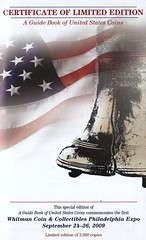 Whitman did an overprinted 2010 Redbook that was given to all the table holders at the recently completed Philadelphia show. They also made extra copies available for $50 to the badge holders. This money went to the National Federation of the Blind (they had a table at the show). We hope the photo reproduces well for you and the readers of The E-Sylum.
Whitman did an overprinted 2010 Redbook that was given to all the table holders at the recently completed Philadelphia show. They also made extra copies available for $50 to the badge holders. This money went to the National Federation of the Blind (they had a table at the show). We hope the photo reproduces well for you and the readers of The E-Sylum.
We'd like to also mention that literature dealers John Burns and Charles Davis had tables at the show besides Wizard Coin Company which is the new enterprise dealer for the American Numismatic Association.
David Crenshaw, General Manager of the Whitman Coin & Collectibles Expo writes:
Now is your chance to support the National Federation of the Blind and add a rare edition of the Guide Book of United States Coins to your collection, at the same time!
All proceeds from the sale of the 2010 Philadelphia Expo Red Book will go to the National Federation of the Blind, a worthy nonprofit supported by Whitman Coin & Collectibles Expo and Whitman Publishing. This limited edition's exclusive print run will be limited to 2,009 copies.
The price is $50 each while supplies last. Telephone orders only: call 1-800-546-2995 to request your copy today. Ask for the 2010 Philadelphia Expo Red Book, item #0794828191.
Thank you for supporting the National Federation of the Blind!
BOOK REVIEW: OVERSTRUCK GREEK COINS BY DAVID MACDONALD
Ed Snible writes:
Although this book is readable it's not intended for beginners. MacDonald doesn't waste a lot of space defining terms that you already know. It's also not a catalog. In the preface it's made clear that the book isn't even trying to list all commonly encountered overstrikes. It's unlikely but possible that catalogers will start including "MacDonald -" when selling overstrikes.
This isn't a breathtaking coffee table book listing the highlights of Greek coin art. The coins are nicer than average grade, and often uglier than average. As MacDonald points out
Overstruck coins are usually ugly. They are not popular with most collectors and, consequently, are avoided by many dealers.
What makes this book wonderful is that the overstruck coins are used to jump into open questions on dating of ancient coins. MacDonald describes simply the currently accepted dating and why it might or must be wrong. He gives enough hints that I could follow the arguments without having to go look up stuff in other books. That's the real strength of this book. In a lot of journal-level numismatic writing the authors are writing towards other PhD classics professors which makes them hard to follow. This book is much smoother.
Because only 160 coins are discussed in nearly 300 pages there is enough room to give background on the coins. We get a lot more than who's on the front and a date range like "480-460". Each coin gets a quality discussion which tells us not just the the issue dates, but often tell us which expert proposed the dates and the historical events that begin or close the date range.
Note that the cover picture on this post, from Whitman's web site, isn't the cover of the actual book, although they are similar. The fake cover says 'Edited by' David MacDonald. The real cover shows those five coins and two more.
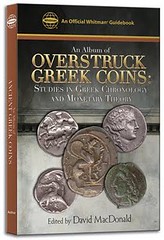
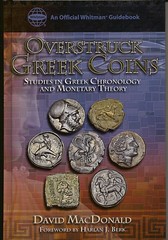
To read Ed Snible's review, see: Overstruck Greek Coins (digitalhn.blogspot.com/2009/10/overstruck-greek-coins.html)
I guess I'm one of those beginners who could have used a little more introductory text, but what is there is quite good. I enjoyed reading about the history and use of overstriking and countermarking in the ancient world. My own introduction to the practice came at a talk by Roy Van Ormer at the Western Pennsylvania Numismatic Association many years ago. Roy talked about 19th century counterstamps on U.S. coins, a series I began collecting myself shortly thereafter.
Overstrikes and countermarks in the Greek world were primarily economic in nature, although many also had some aspect of advertising (but of a political rather than commercial nature).
The majority of coins in the book were completely overstruck on an earlier coin, but there are some countermarks, such as the countermark of a Lion's Head shown on page 116 (Lysimachia c227-250 B.C>).
Each coin illustration is accompanied by a line drawing showing where to look for indications of the design of the undertype coin. I found these very useful and I'm sure they took a great deal of time to produce for the book. I also greatly appreciated Appendix B, which illustrates all of the coins pictured in the book at actual size.
It was interesting to see a group of square coins (p201-208). One is pictured on the book's cover. The rare shape is remarkable as an exception to a steadfast rule - coins are generally round. Why that is is one of my favorite numismatic questions, and I enjoy discussing it with new collectors: Just why are (nearly) all coins are round?
I noticed one typo in the introduction - the author wrote "close systems" where I think he meant "closed systems" (page xi). And on page 87 I just didn't get the reference to "an obvious numismatic pun." As as a neophyte student of ancients I'm in no position to critique the author's research, but his arguments are well presented. He makes what seem to be good cases for the chronology of events surrounding the making and overstriking of these coins. I think the book will be a great addition to the library of anyone who collects or deals in these coins.
-Editor
BOOK REVIEW: WHITMAN ENCYCLOPEDIA OF U. S. PAPER MONEY
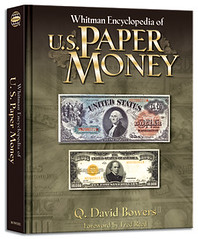 We attended the First Annual Coin and Collectibles Philadelphia Expo held on September 23 – 26, 2009 at the Pennsylvania Convention Center which was sponsored by Whitman Publishing, LLC. We were there to represent the ANA at a free table that Whitman was gracious to let us have. Thank you David Crenshaw, your staff along with Whitman Publishing. We also attended the sale by Stack's of the First Session of Chester L. Krause's Wisconsin Obsolete Note Collection.
We attended the First Annual Coin and Collectibles Philadelphia Expo held on September 23 – 26, 2009 at the Pennsylvania Convention Center which was sponsored by Whitman Publishing, LLC. We were there to represent the ANA at a free table that Whitman was gracious to let us have. Thank you David Crenshaw, your staff along with Whitman Publishing. We also attended the sale by Stack's of the First Session of Chester L. Krause's Wisconsin Obsolete Note Collection.
What immediately caught our attention at the Stack's auction lot viewing room was this large book sitting on a ledge near the entrance of the room. This book was the Whitman Encyclopedia of U. S. Paper Money authored by Q. David Bowers with a Foreword by Fred Reed. We were amazed at the size and scope of this new reference. It premiered at this First Whitman Convention in Philadelphia.
The book has all the attributes of another, "Touchdown or Grand slam," for prolific author Q. David Bowers. Coming in at just under six pounds, this hardbound Whitman Encyclopedia of U. S. Paper Money has 900 pages filled with valuable information on U.S. Paper Money. It is possibly the finest reference ever written on the subject and may be one of the best books ever by award-winning author Q. David Bowers. It was very enjoyable for us to read, and once we started to read - we found it hard to put down.
Of great importance, not only to new collectors but also to those who are advanced Chapters 1 to 5 contain invaluable information on: Introduction and overview, history and overview of Federal Notes, the development and federalization of paper money, grading, and how to be a smart buyer. The 90 pages within these first five chapters will take the reader on a very interesting and informative ride on anything and everything you wanted to know about U.S. Paper Money.
Chapter 5 would be especially useful to any novice or even advanced collector and deals with how to be a smart buyer. We learned a lot from the four steps to success in this chapter which are:
- 1. Grade Assigned.
- 2. Eye Appeal at First Glance.
- 3. A Closer Look.
- 4. Establishing a Fair Market Price.
Reading these four steps would benefit you greatly if you wanted to pursue the collecting of or investing in U. S. Paper Money.
We collect most U. S. Paper Money from Colonial, to modern U. S. Small Size Notes. We particularly enjoyed going through Chapters 6 to 17, which individually contained information on notes denominated from $1 to $100,000. As collectors, we rarely collect anything over the $20 denomination, but if we were to pursue higher denominations this reference would certainly help.
The book contains more than 1,600 full-color images, and in most cases more than four grade and price valuations. The Federal Reserve Note section shows the number of notes printed as well, in most cases, the estimated current population and recent auction results for that note by signature combination or city where applicable.
It next lists Postage and Fractional Currency 1862- 1876 with all of the varieties and five conditions with estimated market values. This is an area of the hobby that is overlooked by most dealers and collectors. If people knew the actual rarity of these "small change notes" everyone would collect them. A short section on paper-money errors covers only the basic errors giving no values. The book also covers star notes and mules.
Continental Currency, 1775-1779 with pictures of representative notes are shown. Prices are shown by date on the note with quantity issued. Prices are given in summary form in seven conditions.
Early 19th Century Treasury Notes from 1812 to 1860 are also shown with some pricing. The last area covered is U. S. Encased Postage Stamps. A representative obverse and reverse is shown for each issuer and prices on all varieties. Prices from recent auctions are shown for the rare pieces.
The book ends with a list of the signatures on U.S. Currency from 1861 to date, and the terms of service of Treasury Officials, 1913 to date.
In many cases, we find the Bibliography in Q. David Bower's references very useful. In this reference we found some new books that will be useful in stories we plan do, along with exhibits we are building. This reference also contains the Friedberg and Whitman Numbering Systems. We can now go over our collection and utilize these numbering systems, which are the standard in the collecting of U. S. Paper Money.
In summary, we feel the book is a must have for all collectors and dealers of U. S. Paper Money. We also recommend it to anyone with an interest in the monetary system of our country. Buy the book, if for nothing else, quoting the recent Whitman Press release (on this reference), it will help you to "Make wise purchases in today's market." It is another "can't miss" reference authored by one of the greatest numismatic authors of all time. The book is 8 ½ x 11 inches and retails for $69.95 and can be purchased from your local coin dealer or from Whitman Publishing, LLC, Main Office, 3103 Clairmont Road, Suite B, Atlanta, GA 30329 or call (800) 546-2995 or at the Whitman web page, www.whitmanbooks.com .
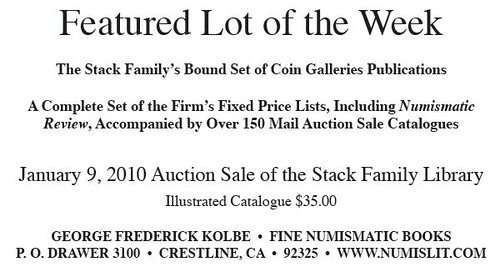
MORE ON THE PROFESSIONAL EDITION RED BOOK
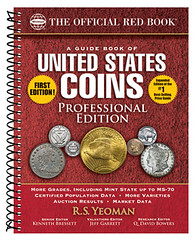 Thank you for giving me the opportunity to answer E-Sylum readers' questions about the new Professional Edition of the Red Book. At the Philadelphia Expo, Ken Bressett, Dave Bowers, Jeff Garrett, and I did a presentation on the book. Collector interest was piqued, and we fielded quite a few questions similar to the ones asked here by Alan Luedeking, Gary Dunaier, and Joe Boling.
Thank you for giving me the opportunity to answer E-Sylum readers' questions about the new Professional Edition of the Red Book. At the Philadelphia Expo, Ken Bressett, Dave Bowers, Jeff Garrett, and I did a presentation on the book. Collector interest was piqued, and we fielded quite a few questions similar to the ones asked here by Alan Luedeking, Gary Dunaier, and Joe Boling.
(Before I continue, I'd like to extend an offer to E-Sylum readers. At the Philly Expo we distributed an 11 x 17 double-sided broadsheet to the show's dealers. With text and photos it describes the content and layout of the Professional Edition, and answers many of the questions their customers will have about the book. I have a few extra prints of this broadsheet, and if any E-Sylumites would like a copy they can send me their mailing address at dennis.tucker@whitmanbooks.com, and I'll drop one in the mail.)
To sum it up, the Professional Edition of the Red Book is an enlargement and expansion of the regular edition's coverage of federal coin issues, with several additional sections, intended to serve the intermediate to advanced collector, the variety specialist, the professional coin dealer, the auctioneer, the investor, and the numismatic researcher.
In order to keep the Professional Edition to a manageable page count, we did not include the regular edition's introductory overview of the history of U.S. coinage, or its stories about coins from treasures and hoards. We also didn't include colonial and early American coins and tokens; silver, gold, and platinum bullion coins; private and territorial gold; Hard Times tokens; Civil War tokens; Confederate coins; Hawaiian, Puerto Rican, and Philippine coins; Alaskan tokens; misstrikes and errors; numismatic books; and other "front-of-the-book" and "back-of-the-book" topics covered in the regular edition.
Those areas will continue to be covered in the annual regular edition of the Red Book. Even though the pages of the Professional Edition are 45% larger than those of the regular edition, expanding on all of those topics would have resulted in an 800- to 900-page book! By focusing on federal coinage---half cents though double eagles---plus early Proof and Mint sets, and classic commemoratives, and including a few new sections, we were able to create a large-sized 384-page book with a reasonable retail ($29.95).
Okay, so what do I mean by "expanded" coverage?
1. The Professional Edition includes introductions (typically one to three pages) on each denomination---an overview of its history, major design types, and general collectability by type; plus a more in-depth analysis of specializing in that denomination. These sections encapsulate decades of numismatic research and market observation, and they should be read in conjunction with the charts, photographs, and other information that follow.
2. Each denomination is then broken out into detailed type-by-type studies. These include charts similar to those found in the regular edition (e.g., with detailed mintage date), but also including
- certified population data: For each circulation-strike coin, a summary is provided of a) the number of coins certified, b) the average grade, and c) the percentage of coins certified in Mint State. For early (generally pre-1916) Proof coins, certified populations are summarized as a) the number of coins certified, and b) the level of the finest Proof known. For later Proofs, the data includes a) the number of coins certified, and b) the average Proof level. These summaries provide the collector and investor with working data useful in comparing coins offered for sale or bid.
- valuations: Values in the Professional Edition reflect retail and auction prices for professionally certified coins seen in today's market. These start at the high end of the grades covered in the regular edition, and focus upward into high-circulated and Mint State grades. Expanded coverage here includes higher MS levels, as well as detailed analysis of Red-Brown and Red copper coins, Full Bell Lines, Full Head, Full Steps, Split Bands, Cameo, Deep Cameo, and similar designations.
- auction records. An auction record (highest price paid) is provided for every coin that has sold for $1,000 or more (and some lower), generally within the past eight to ten years. Each record includes a) the price paid for the coin, b) the grade, c) the auction firm, and d) the date of the auction. This is similar to the coverage included in the regular edition for exceptional coins, but is included for each date.
In addition to these expanded records and valuations for each coin, the Professional Edition includes summary information on each type's history; aspects of its strike, sharpness, and related characteristics; and its market availability. Detailed grading guidelines are included for the grades covered in the charts.
(I'm trying to be as detailed as possible in my explanations here; collectors who perused the advance galley at the Philadelphia Expo saw what I'm describing, and the broadsheet I mentioned shows example pages.)
The Professional Edition includes many more VAMs, doubled dies, repunched mintmarks, and other popular and valuable varieties than the regular-edition Red Book. Every year at Whitman Publishing we get phone calls, letters, and emails requesting coverage of additional varieties in the regular edition, but space---and the "general overview" nature of the regular edition---don't allow for such extended coverage. With the Professional Edition, we have the page space to go into much more detail, not just in valuations but also in enlarged close-ups, explanatory chart notes, captions, etc.
The Professional Edition includes advanced study of early Proof coins—mintages, numbers known, certified population data, valuations, auction records, varieties, and photographs of early 1800s to early 1900s Proof coins in copper, silver, and gold. Because these coins are outside the field of the typical beginning to intermediate collector, the regular-edition Red Book gives them only brief mention.
The Professional Edition also includes expanded coverage of classic (pre-1982) commemoratives, and Proof and Mint sets to 1964, plus the Special Mint Sets of the 1960s.
The Professional Edition has a detailed appendix on modern counterfeit coins, including a classification system developed by Dr. Gregory DuBay, photographs of counterfeit coins and dies, the full text of the Hobby Protection Act, advice on identifying counterfeits (including illustrated examples from Bill Fivaz), and more.
A gallery in the back includes enlarged photographs of early copper, silver, and Proof coins, by type.
The regular edition of the Red Book remains a valuable resource for information on lower-grade circulated coins (typically AG through AU, as well as lower Mint States). There is some overlap in the grades covered by the regular and Professional editions, but for the most part the Professional Edition covers higher grades. Also, as mentioned, the Professional Edition doesn't include colonials, territorial gold, and other non-federal coinage, tokens, and medals covered in the regular edition.
To summarize: everything that readers are used to finding in the regular edition of the Red Book will continue to be published there, in annual volumes. The Professional Edition will also be published annually. Undoubtedly, each will continue to feature special sections each year (like the regular edition's recent section on American Arts gold medals [2009 edition] and its expanded coverage of rare error coins [2010 edition]).
The Professional Edition debuts this week (October 13). It will be available online, from hobby dealers, and in bookstores nationwide. Again, I'd be happy to send a free copy of the Philadelphia Expo broadsheet to interested E-Sylum readers while the supply holds out---or, once the book becomes available, readers can see for themselves what the new Professional Edition is all about. In the meantime, I hope this description answers general curiosity. My email is dennis.tucker@whitmanbooks.com if anyone has further questions.
AMERICAN NUMISMATIC SOCIETY PUBLICATION HISTORY
I recently finished a website on the history of the Society's publications program: www.numismatics.org/Archives/PublicationHistory
The site (hopefully!) now lists every publication the ANS has issued since 1858. For monograph series there are brief descriptions of why each was created and what was necessary for a work to qualify for publication in that particular series. For periodicals, there are brief descriptions of each series, along with date ranges for when each was published.
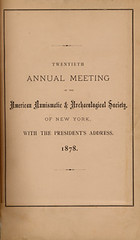
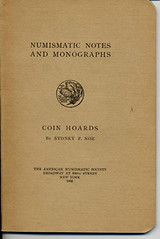
The site's been in development for a few years now, but I only recently finished adding the last of the monographs. I may be biased but I think it provides a great resource for anyone who either collects ANS publications or is simply interested in the history of the Society's publications program. Admittedly, I did not include a few things like reprints. Otherwise, I think I've captured everything. I'd be curious to learn if your readership knows of any additional publications which should be included.
I also wanted to let you know that I'm leaving the ANS next week, in part because I will be working as the corporate librarian for Standard & Poors and managing what looks to be a fairly substantial library. Before I left, however, I did want to thank you and your readership for all their support during my tenure at the ANS. The feedback I received, either on or offline was very helpful.
I should note that I will still be continuing my consulting business (www.cicconearchives.com in case anyone's interested!)
Thanks again for all your help!
DICK JOHNSON: LAUNCHING A NEW MEDAL AND A NEW BUSINESS
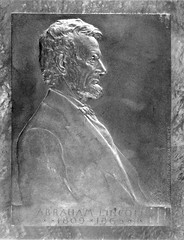 I added a new line to my résumé recently: medal publisher. This was added to writer, editor, cataloger (and formerly medal manufacturer and dealer). With a very talented and savvy partner, we have just published a medal -- actually a plaquette -- honoring Abraham Lincoln and Victor David Brenner. After all, the year 2009 is the bicentennial of the birth of Lincoln and the centennial of Brenner's Lincoln Cent.
I added a new line to my résumé recently: medal publisher. This was added to writer, editor, cataloger (and formerly medal manufacturer and dealer). With a very talented and savvy partner, we have just published a medal -- actually a plaquette -- honoring Abraham Lincoln and Victor David Brenner. After all, the year 2009 is the bicentennial of the birth of Lincoln and the centennial of Brenner's Lincoln Cent.
It started March 2008 when I received a phone call from Mark Schlepphorst, a medal collector from Groton, Massachusetts. Mark was enamored with Brenner's Lincoln and wanted to learn more about Brenner's medallic work and everything I knew about the 1907 plaque of Lincoln which Brenner had created. This plaque -- the one mounted on the green marble -- was the impetus for his inquiries and the subject of our many conversations.
It lead Mark to become quite knowledgeable about all Brenner's Lincoln medals and acquiring every size and variety in existence. That includes the super Brenner Lincoln rarity, the Lincoln Medal Desk Plaque (King 303 obverse and reverse shown side-by-side separated by eagle overhead). We speculated about what would be issued medalically for the Lincoln birth bicentennial as we reflected on the enormous outpouring of Lincoln centennial medals for 1909.
I don't recall who had the idea first -- why don't we issue a Lincoln Bicentennial Medal? I did mention to Mark I knew Medallic Art Company acquired a number of Lincoln items on two separate occasions from Sam Brenner, Victor's younger brother, once in 1929 that included the original mold for that 1907 Lincoln Plaque and a second time, in 1931, when the firm acquired four dozen or more galvanos and medallic patterns.
Mark was ecstatic. Could that original 1907 mold still be in existence? Could it be used for a 2009 medal? "It was in Medallic Company's die vault when I left the firm in 1977," I stated. The firm had moved several times since then. From its original location on East 45th Street in midtown Manhattan, to Danbury Connecticut in 1972, acquired by Bob Hoff in 1989 and moved to Sioux Falls, South Dakota, and finally relocated to Dayton, Nevada in 1997.
Mark flew to Nevada to meet with Bob Hoff, owner of the firm. The original mold was indeed still in custody of the company! Mark contracted for a 2-year exclusive use for that mold. Now, when he returned, he approached me. Let's set up a new firm to issue a Lincoln Bicentennial Medal. "How best can we do this?" he challenged me.
The original was a foundry cast, I replied. It was acquired in 1929 and issued by Medallic Art in the 1930s as an electrolytic cast, a galvano. "We must do something entirely different" I stated. I insisted it be a struck piece. A die could be cut from the original image. And make it as large as could be struck on an existing medal press.
How large? We tossed that question back to Bob Hoff at Medallic Art. He speculated it could be exactly half the size of that original to be struck rather than cast. The original cast plaque is over ten inches tall. That would make the half size plaque more that 5 inches tall. Could a press strike that? And what could be the design for the reverse?
For answers to those questions check out next week's issue of E-Sylum. I'll finish the saga -- the accomplishments and delays, the peaks and valleys, the elations and frustrations -- of bringing such a unusual and distinctive piece to market, for collectors to own and enjoy.
NOVA CONSTELLATIO PATTERN SET SURFACES IN PHILADELPHIA
These coins were the original prototypes for the national coinage of the United States. Ford considered them a highlight of his collection, and re-assembling them after 200 years was a considerable numismatic feat. So where was it? As a subscriber to the hardbound Ford sale catalogs, I felt cheated - without the Nova Constellatio set, there was a huge hole in the record of Ford's collection.
I'd heard some rumors of what happened to the set, most of which turned out to be incorrect. But Stack's was mum and I had no official word to publish. Well, I wish I'd been able to make the recent Whitman Philadelphia Expo, because the set was there, on display for all to see. -Editor
An E-Sylum reader writes:
I recently attended the Philadelphia convention, and I saw something there that stunned me.
What first caught my eye was a Plexiglas housing containing some very valuable paper money rarities, including the famous 'Grand Watermelon' $1,000 Treasury note. After looking at that display, I noticed some coins in a neighboring display case. Unless I'm mistaken (and I easily could be), the coins in this Plexiglas housing were the Nova Constellatio patterns that John Ford bought at one of the Garrett sales.
After viewing what I thought to be the Garrett/Ford patterns, I asked a security guard who was minding the exhibit who owned them. He said a Southern collector who wished to remain anonymous owned them. He then volunteered that the coins were owned by the same person who owned the paper money rarities in the adjacent display.
Not being an expert in coins, and particularly unknowledgeable in colonial era numismatics, I thought I would lay back and wait for someone else to contribute this story to The E-Sylum. But The E-Sylum Philadelphia show coverage had nothing about the display of the patterns.
Since I no longer subscribe to Coin World, I have no idea if the mainstream numismatic media picked up on this.
P.S.: I'm enclosing an article from the web about these coins written by some hack in 1994.
The "hack" our writer jokingly refers to was Yours Truly, writing on July 21, 1994, over three years before The E-Sylum came to be. Here's what I wrote. Forgive the repetition, but these comments were made over a span of 15 years, so at least I'm consistent...
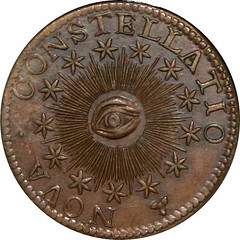
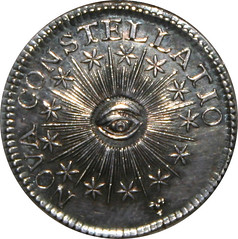
This week's Numismatic News announced that John Ford's unique 1783 Nova Constellatio pattern set will be on display at Stack's table at the ANA Convention next week. Wow! To me, this set is the ultimate U.S. numismatic treasure, far more important historically than the King of Siam set (of 1804 Dollar fame).
The coins were struck in April 1783 for Robert Morris, and were the first attempt to create a national coinage for the new government. The denominations were based on a unit equal to 1/440th of a Spanish Milled Dollar. The silver "mark" was 100 units, the "quint" 500, the "bit" 100. The smallest was a copper "5".
The following is the story of Ford's acquisition of the set, as near as I can remember it. I have a tape recording of a talk he gave one time, and spoke to him in person about it once. He had a lot of explaining to do to his wife when he needed to liquidate other assets to come up with some cash after the Garrett sale.
Ford bought the copper "five" in 1977. It was found in a Paris collection and was sold to a U.S coin dealer who thought it was a pattern for the later Nova Constellatio copper coinage--he didn't realize it was the missing link in the Morris set (the other three silver pieces resided in the Garrett collection at Johns Hopkins University). The dealer offered it to a wealthy collector who in turn asked John Ford for his advice. The collector met Ford in midtown Manhattan while on the way to a fishing trip. As the two shared a cab, the collector pulled the piece from his shirt pocket and showed it to Ford.
"How much should I pay for it" he asked. "Just buy it," Ford said, recognizing the significance of the piece. "But how much is it worth?" "Just buy it--whatever it takes--buy it!" The collector put the piece back in the pocket of his fishing shirt, and left for the woods. When he later contacted the dealer, the asking price was $20,000, and the collector balked. He sent the coin back to the dealer.
Before long John Ford got a call himself from the dealer, and later bought the piece for his own collection. Two years later, Ford bought the remaining three pieces at the Garrett sale for $425,000. The set of four coins that passed through the hands of Morris and Thomas Jefferson was united again after nearly 200 years.
After holding the set for 15 years, Ford is apparently putting it up for sale. "The price is available on request." Those of us who'd have to ask, can't afford it. But this collector will make sure he takes the opportunity to see the coins before they disappear for another 15 years or more.
To read the complete article, see: The 1783 Nova Constellatio Set (www.limunltd.com/numismatica/stories/nova-constellatio-set.html)
When Ford passed away I published a special issue of The E-Sylum the next day (July 8, 2005). I wrote:
I recall sitting with him at the Stack's table at the Detroit ANA, where I had been viewing his Nova Constellatio silver pattern set, which he was offering for sale through them. I was transfixed as I examined what I still feel is one of the most important sets of U.S. coinage ever made. John had told me about how he bid on the pieces he bought from the Garrett sales while we spoke at Champa's.
To read the complete E-Sylum article, see: JOHN J. FORD, JR. (www.coinbooks.org/esylum_v08n28a01.html)
Now leap forward to 2009. This article was posted September 25, 2009 on the Whitman web site.
Whitman's own Q. David Bowers appeared on Philadelphia's FOX29 this morning, with Nova Constellatio pattern coins, the $1,000 "Grand Watermelon" Note and Sansom Medals. Mr. Bowers told viewers how to have their coins evaluated by dealers at the Whitman Coin & Collectibles Philadelphia Expo, now through Saturday at the Pennsylvania Convention Center.
To read the complete article, see: Q. David Bowers on Philly's FOX29 (whitmancoincollecting.com/content/q-david-bowers-fox29/)
Whitman's David Crenshaw forwarded this picture of the exhibit as well as the images of the coins above. He writes:
The young lady is Kimberly Godinho. Learn more about her and her early American coin paintings that were also on display at: whitmancoincollecting.com/content/for-kimberly-godinho-coin-collecting-inspired-art .
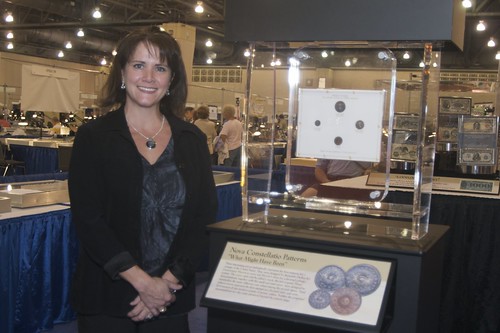
I asked Alan Weinberg, who writes:
Yes, the Nova Constellatio set was displayed vertically in a white Capital Plastics holder in a poorly lighted case at the Philadelphia show. You couldn't really see them well and had to strain your body various ways to see any detail at all. They would have been more wisely displayed flat- so you couldn't see the reverses but at least you could see the obverses ! I hadn't mentioned the Nova display as it was so difficult to see.
They had belonged to John Ford, Jr. who acquired most of them out of the Garrett sale in 1979 but had to sell a great many coins he owned to raise money to do so. Ford was never cash-rich.
Fifteen years ago Stack's got them on consignment from Ford and advertised them, issuing a pamphlet, at $1.5 million and they didn't sell. Then a few years ago they privately offered them at $4 million to Don Partrick who turned them down flat, saying if he had wanted them he'd have paid the $1.5 million years ago. Then Stack's sold them for $4-5 million to the current owner who put them on display.
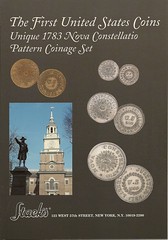 I was fortunate to view the set in 1994 at the Detroit show. I sat down at the Stack's table and they handed me the large white Capital holder. I examined each obverse and reverse with my magnifier. Luckily there were no other viewers at the table, and I must have sat there gawking for 15 minutes or more. And then I saw John Ford walking down the aisle. He pulled up a chair beside me and we talked about the set.
I was fortunate to view the set in 1994 at the Detroit show. I sat down at the Stack's table and they handed me the large white Capital holder. I examined each obverse and reverse with my magnifier. Luckily there were no other viewers at the table, and I must have sat there gawking for 15 minutes or more. And then I saw John Ford walking down the aisle. He pulled up a chair beside me and we talked about the set.
My copy of the 1994 Stack's pamphlet is illustrated here. It's a nicely done 12-page color booklet on glossy paper. A big chunk of the first two pages is wasted with images of a Guttenberg bible and first folio of Shakespeare. Puh-leeze, spare us the marketing crap! We get it. But the rest of the pamphlet is a nice history of the creation and provenance of the set.
It's a shame the coins were denied a first-class catalogue description in the Ford sales. But I doubt that it's Stack's (or anyone's) fault. These things happen for various reasons, and none of us should second guess the decisions of the parties involved, which include not just Stack's but the Ford family and the buyer of the set. At least we now know what happened to it.
The buyer wishes to remain anonymous so I won't spill the beans even though their identity is considered "an open secret" in numismatic circles. Congratulations to the "Southern Gentleman", and many thanks for putting the set on display. -Editor
THE BOOK BAZARRE
2010 BRITISH-AMERICAN TOKEN CONGRESS
The second British-American Token Congress is on for May 13-15, 2010!
This time the host city is Charlottesville, located at the foothills of the Blue Ridge Mountains in the Commonwealth of Virginia. C'ville has a lot to offer, drawing millions of visitors to Monticello, home of Thomas Jefferson, Ashlawn-Highlands, home of James Monroe, and Montpelier, home of James Madison.
The Congress will be held at the Omni Hotel, which has just completed a substantial renovation. It is located directly on the downtown pedestrian mall with dozens of excellent restaurants, bars, music venues, theaters, and interesting shops all within a few blocks.
As with the wonderful Token Congress held in Seattle earlier this year, this event will take place over three days – Thursday, Friday and Saturday with a dinner and bourse Friday evening. A full schedule along with additional event details, logistics, and other points of interest will be posted as soon as we get it together. There is also talk of a private tour of Monticello, so if you are interested please let us know as soon as possible.
For further information please contact: Alberto Washington at albertowashington@hotmail.com
COINTELEVISION.COM ANNOUNCES NEW WEBSITE DESIGN

Cointelevision.com debuts a new website design that features video highlights from the recent Dan Holmes Large Cent Auction Sale. This event was held by McCawley-Grellman Auctions along with Ira & Larry Goldberg Auctions on September 6 at the Crowne Plaza Hotel in Beverly Hills, California. The video clips include the actual sale of lot #128, the 1795 Sheldon 79 reeded large cent, the first copper coin to realize over $1 million at auction.
Viewers can also see an interview with Greg Hannigan of Royal Palm Beach, Florida who purchased the coin. Comments are made by other large cent specialists including auctioneer Ira Goldberg, large cent dealer Chris McCawley, Bob Grellman who catalogued the coins, along with Tony Terranova, Del Bland, Jack Beymer, Jim Neiswinter, Mark Borckardt, John Kraljevich, and Jon Warshawsky. There is an awards ceremony with current EAC President Denis Loring presenting a plaque to outgoing EAC president Dan Holmes. There is also an interview with Dan Holmes himself along with remarks by his wife Joan and daughter Annie.
Cointelevision.com specializes in offering free video news information about the coin industry. The new website features a Video Archive section that has news stories from major auctions and conventions dating back to 2003. Viewers are invited to share in seeing the important events as they really happened from the words of the people who were there when they happened.
A series of DVD's will be available soon that features all the interviews about the auction as well as complete footage of the first 300 lots sold in the Dan Holmes Large Cent auction.
To visit Cointelevision.com, see (what else?): Cointelevision.com
NOTES AND COMMENTS ON LAST WEEK'S ISSUE
Mark Borckardt writes:
I compiled an index to the first 100 issues of Rare Coin Review. I then sent the compilation to Ken and Myron at the Money Tree who tweaked it and published it (and also got the profits, if there were any).
Leon Saryan writes:
Does the American Numismatic Association have the largest numismatic library in the world, as the Monroe, MI newspaper claims, or is that honor reserved for another institution? Sincerely,
Philippe de Henaut writes:
In the September 27th E-Sylum, Dick Johnson expressed an interest in having a memorable acronym based on NIP and Tuck but couldn't come up with the appropriate words for TUCK. I would like to suggest the following for NIP N' TUCK ; Numismatic Type Universal Catalog of Known articles from non-numismatic publications. Admittedly, it's a bit long but . . .
MORE ON NUMISMATICS AND SHERLOCK HOLMES
Paul Petch writes:
In reference to the cited monograph linking Holmes to numismatics, the curious reader will get far more information, and the complete text of the Sherlock Holmes stories, in the two-volume set "The Annotated Sherlock Holmes" by William Baring-Gould.
I consulted a copy of the Simpson text years ago at the Toronto Reference Library and discovered that Baring-Gould had included much of its contents in his annotations. Many inexpensive copies of the Baring-Gould work can be found at AbeBooks.
Alan Luedeking writes:
Further to my piece on Somogyi's 1989 Holmes medals in The E-Sylum Volume 5, Number 27, June 30, 2002, Article 8, I thought I'd share the images with you. For what it's worth, I've never seen any others, and the production quantity of the bronze version is unknown. The silver one is crudely numbered #145 of 310. The quantity of 310 supposedly consists of 300 examples in silver and 10 in gold. Whether this many were ever made is open to question, but judging from my silver piece at least 145 examples should exist. Ms. Somogyi gave me the choice of whether I wanted a hanger or not, so I chose the silver one with and the bronze without. Regrettably, I never bought the gold.
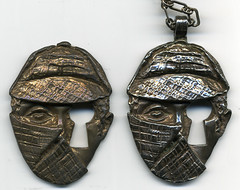
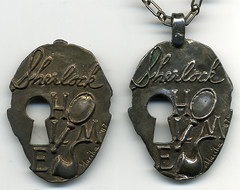
To read the earlier E-Sylum article, see: NUMISMATICS AND SHERLOCK HOLMES (www.coinbooks.org/esylum_v12n40a15.html)
MORE ON ALCOHOLICS ANONYMOUS TOKENS
Alex Siegel writes:
Regarding Alcoholics Anonymous tokens: I have collected these for years. I know of no book or catalog on the nature and variety of these tokens. Personally, I have attributed at least 20+ varieties (for each year of sobriety). If a book on the tokens is published, I'd sure like to find out about it.

FORMER ANA EXECUTIVE DIRECTOR KEEPS LAW LICENSE
Local attorney Christopher Cipoletti can retain his license to practice law while the Colorado Supreme Court's Attorney Regulation Counsel investigates complaints that he breached the Rules of Professional Conduct by converting money that belonged to his former employer. the American Numismatic Association. for his own use, the presiding disciplinary judge ruled Tuesday.
A hearing was held in Denver on Sept. 28 to consider whether Cipoletti's license should be suspended based on allegations presented in a civil lawsuit filed in Fourth Judicial District Court that Cipoletti double-billed personal legal clients and the organization for travel expenses of nearly $10,000.
Cipoletti. who specializes in nonprofit and employment issues, paid back the money with interest.

To read the earlier E-Sylum article, see: FORMER ANA EXECUTIVE DIRECTOR FACES HEARING MONDAY (www.coinbooks.org/esylum_v12n39a24.html)
THE BOOK BAZARRE
CONTRIBUTIONS OF ALCHEMY TO NUMISMATICS
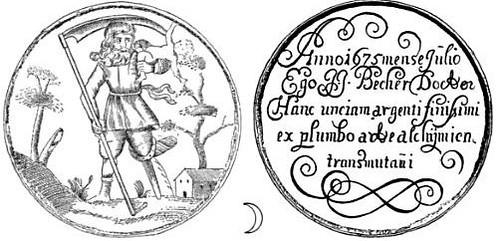
An Augustinian monk named Wenzel Seyler, a native of Bohemia, visited Vienna in 1675, and securing an interview with the reigning Emperor, Leopold I, son of Ferdinand III, accomplished in his presence a successful projection. He converted a copper vessel which had been brought to him into gold. He also changed tin into gold, and from the precious metal the Emperor caused ducats to be struck, stamped only on one side ; these bore on the obverse a portrait bust of the Emperor with the words: Leopoldus D.[ei] G.[ratia] R.[omanorum] I.[mperator] s.[emper] A. [ugustus] G.[ermanl«] H.[ungari/e] E. [t] B.[oheml/e] R.[ex] (Leopold, by the grace of God, the ever august Emperor of the Roman Empire, King of Germany, Hungary and Bohemia.) On the reverse the year 1675, and the couplet:
which may be paraphrased thus :
The above image is the only one I saw in the book. It's on the frontispiece, and although the date is 1675 it doesn't correspond to the piece mentioned in the excerpt. -Editor
To read the book, see: Google Books: Contributions of Alchemy to Numismatics
CONTEMPORARY THOUGHTS ON THE 1878 GOLOID DOLLAR PROPOSAL
Speaking of transmuting gold, while pawing through my files of old newspapers this weekend I came across one interesting contemporary opinion on the proposed Goloid dollar. First, some background from the USPatterns.com web site:
1879 Barber Goloid Set
This year marked experiments in the use of goloid alloys. Goloid was an alloy patented by Dr. Wheeler Hubbell and consisted of gold, silver and copper in various proportions. They were used in an attempt to make the silver dollar smaller and lighter and in the creation of the famous $4 gold piece or Stella for use as an international coinage.
Charles Barber created 2 dollar and 1 Stella design as part of this testing. 15 sets were made for the Congressional Committee on Coinage presumably using the goloid alloys. These were apparently popular with congressmen and another 400 sets were ordered which are believed to be of "standard" silver and gold.

For more information from USPAtterns.com, see: 1879 Barber Goloid Set (uspatterns.stores.yahoo.net/18bargolset.html)
On December 30,1878 the San Jose Mercury commented on the proposed coinage. Maybe this is why the idea flew like a lead balloon...
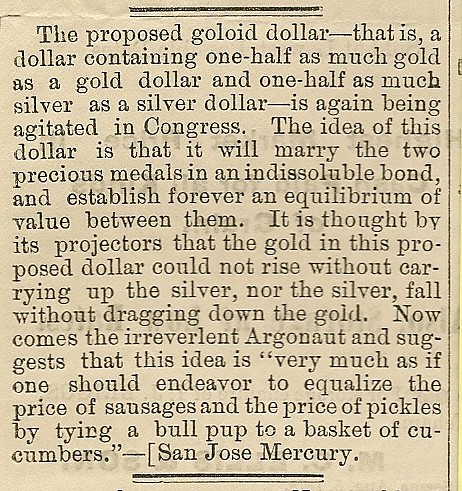
COINS FOR HARD TIMES: ARTIST MAKES HIS OWN MONEY
 Matthew Hinçman is what some people call a guerilla artist. Guerilla Art, sometimes called Street Art, is unsanctioned art that is developed and displayed in public places. Guerilla art is more than graffiti. It is art designed to surprise and make the public think and sometimes participate.
Matthew Hinçman is what some people call a guerilla artist. Guerilla Art, sometimes called Street Art, is unsanctioned art that is developed and displayed in public places. Guerilla art is more than graffiti. It is art designed to surprise and make the public think and sometimes participate.
One of Hinçman's newest projects is the creation of Pomme de Terre (French for "Potato") and Pomme en l'Air ("Apple in the Air") tokens. Hinçman describes them as "loosely based on mid-19th century Hard Times Tokens." He had 1,200 copper tokens minted and will drop them on the streets of Boston by the end of the year.
Those in the Boston are may want to follow Hinçman on Twitter @metchew for clues as to where he drops the token.
Hinçman also had 50 silver tokens minted but has not announced plans for those tokens.
Interestingly, this is the second time I found an artist making a statement about or with money using art. Rather than the existing bureaucracy, maybe we should include more of these artists in the process. They seem to come up with better ideas.
To read the original blog post, see: Neat Coin Drop in Boston (coinsblog.blogspot.com/2009/10/neat-coin-drop-in-boston.html)
I ran into artist Matthew Hincman last week, who has decided that things have gotten bad enough that it's time to create your own money.
Hincman designed the coin above and had 1,200 minted in copper, which he plans to leave on the ground at random locations for people to pick up and puzzle over.
Hincman figures there's no law against leaving coins around. He says sometimes drops to one knee and pretends to be tying his shoe, then casually deposits one on the sidewalk.
To read the original blog post, see: Coins For Hard Times: Artist Makes His Own Money (http://www.npr.org/blogs/money/2009/10/hard_times_coins.html)
SERGEY BRIN DEFENDS GOOGLE BOOKS
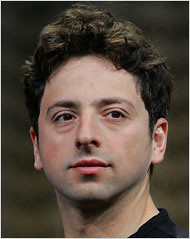 Because books published before 1923 are in the public domain, I am able to view them easily.
Because books published before 1923 are in the public domain, I am able to view them easily.
But the vast majority of books ever written are not accessible to anyone except the most tenacious researchers at premier academic libraries. Books written after 1923 quickly disappear into a literary black hole. With rare exceptions, one can buy them only for the small number of years they are in print. After that, they are found only in a vanishing number of libraries and used book stores. As the years pass, contracts get lost and forgotten, authors and publishers disappear, the rights holders become impossible to track down.
Because books are such an important part of the world's collective knowledge and cultural heritage, Larry Page, the co-founder of Google, first proposed that we digitize all books a decade ago, when we were a fledgling startup. At the time, it was viewed as so ambitious and challenging a project that we were unable to attract anyone to work on it. But five years later, in 2004, Google Books (then called Google Print) was born, allowing users to search hundreds of thousands of books. Today, they number over 10 million and counting.
The next year we were sued by the Authors Guild and the Association of American Publishers over the project. While we have had disagreements, we have a common goal — to unlock the wisdom held in the enormous number of out-of-print books, while fairly compensating the rights holders. As a result, we were able to work together to devise a settlement that accomplishes our shared vision. While this settlement is a win-win for authors, publishers and Google, the real winners are the readers who will now have access to a greatly expanded world of books.
For those books whose rights holders have not yet come forward, reasonable default pricing and access policies are assumed. This allows access to the many orphan works whose owners have not yet been found and accumulates revenue for the rights holders, giving them an incentive to step forward.
There really ought to be a pathway toward unlocking these works while still enabling the true copyright holder to come forth at a later date and claim their rightful stake. This turns the chicken-and-egg problem into an egg-and-chicken problem. Only if the orphaned works are FIRST digitized will many of the true copyright holders even learn of their existence.
Once revenues are created that can later be claimed, you can bet there will suddenly appear an army of miners panning for gold in them thar hills. And in the long run, that will ensure that there are fewer orphaned works in the first place, and those that remain orphaned will probably be the ones most deserving of that status. And throughout it all, more of the world's knowledge will be freed from the shackles of physical space.
Back in the day, at the height of the Internet bubble, I interviewed for the position of Product Manager for the search engine at Lycos. One of the interviewers asked me what I would do to improve the product. I told them I'd start digitizing the world's books. But those were the days when memory was still relatively expensive. I timidly proposed initially digitizing only the title, table of contents and index.
I got the job. A lot of my ideas, including this one, fell on deaf ears. But later came Google and orders-of-magnitude cheaper memory. Google Books is succeeding in its purpose, but we're only gettin' warmed up, folks. The millions of books digitized so far are only the tip of the iceberg.
-Editor
To read the complete article, see: A Library to Last Forever (www.nytimes.com/2009/10/09/opinion/09brin.html)
WASHINGTON POST CLIPPINGS ON VARIOUS TOPICS
The fast-talking and well-dressed Texas customs broker has arrived at the Treasury Department twice in recent years with luggage stuffed with crusty, grimy greenbacks. The money was ruined, he said, and worth about $6.4 million.
Only now, after delicately counting the bills and running down leads, are authorities and attorneys for the broker's clients unraveling the mystery of the Mexican moola. Their answers are not particularly satisfying. But that shouldn't be a surprise. They are talking about buried treasure, after all.
"This would make a great book or a movie," says David B. Smith, a lawyer representing the broker's clients. "It's offbeat. It has characters."
The Mexican cash sheds light on what is normally a little-noticed program at the Bureau of Engraving and Printing in downtown Washington. Each year, the bureau handles about 30,000 transactions involving mutilated currency worth $30 million, according to its tersely worded Web site.
To read the complete article, see: Damaged Money, Priceless Stories (www.washingtonpost.com/wp-dyn/content/article/2009/10/04/AR2009100403045.html)
One of my favorite subjects is business history. And one of my favorite books on that subject is Joseph Frazier Wall's biography of steel industrialist Andrew Carnegie.
I could go on about Carnegie, who wasn't perfect but was a business genius. His philanthropic legacy includes Carnegie Hall, the Carnegie libraries, the Carnegie Endowment for International Peace and -- believe it or not -- the precursor to the TIAA-CREF retirement fund. Look it up.
When Bruce Weindruch, founder of a D.C. area business called the History Factory, told me it was Prof. Wall who launched him on his career path chronicling the history of business, well, let's just say Bruce and I had a lot to talk about. Weindruch is a business-history junkie who can wax for hours on the financial genius of Andrew Mellon (Alcoa, Gulf Oil) or the organizational skills of Alfred P. Sloan (General Motors).
Weindruch, 55, has done a cool thing. He has taken the subject of business history and found a way to build a successful business around it. The History Factory builds Web sites, makes films, writes books and creates exhibits for clients around the world, be they massive oil producers such as Saudi Aramco or the Renaissance Mayflower Hotel in downtown Washington.
He leads a team of 35 historians, archivists, library scientists, writers, curators, designers and businesspeople at the company's home office in Chantilly. And he makes a nice living doing it.
To read the complete article, see: Corporate History Becomes a Business of Its Own (www.washingtonpost.com/wp-dyn/content/article/2009/10/04/AR2009100402488.html)
The elevator opened on the top floor of the Library of Congress's Adams Building. The word dick strolled out, a bulging backpack slung over his shoulder. He walked past the guard, through the reading room, then pushed through a door marked "Authorized Staff Only" and unlocked his office.
Light from an overcast sky slanted in through the slats of the Venetian blinds. A battered desk groaned beneath a mountain of books: "The Journal of Documentary Reproduction," "The Complete Book of Surfing," "Studs Lonigan," an ordnance manual from 1841.
"You're a detective," said Jon Simon of his job, "trying to find the first use."
The first use. That magical moment a word makes its first tentative steps into the English language, chosen by a writer, published in a novel or a newspaper. These things matter when you work for the Oxford English Dictionary, as Jon, the word dick, does.
That's "dick" as in "a detective; a policeman," used, according to the Oxford English Dictionary, as early as 1912 by author A.H. Lewis in his book "Apaches of N.Y.": "Still, those plain-clothes dicks did not despair."
To read the complete article, see: Sleuthing the Source, Syllable by Syllable (www.washingtonpost.com/wp-dyn/content/article/2009/10/04/AR2009100402300.html)
THE BOOK BAZARRE
POLYMER BANKNOTE FIRM CHARGED WITH BRIBING OFFICIALS
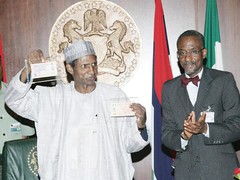 On Wednesday September 30, at the Presidential Villa in Abuja, President Umaru Musa Yar'Adua smiled and beamed as he launched the polymer currency notes for the country. But far away in Australia, crack detectives were reviewing case files in Canberra, making sense of which, and how many, Nigerian officials shared about 750 million Naira in bribe money from the Australian polymer company, Securency, to secure the contract to supply the polymer notes to the Nigerian government.
On Wednesday September 30, at the Presidential Villa in Abuja, President Umaru Musa Yar'Adua smiled and beamed as he launched the polymer currency notes for the country. But far away in Australia, crack detectives were reviewing case files in Canberra, making sense of which, and how many, Nigerian officials shared about 750 million Naira in bribe money from the Australian polymer company, Securency, to secure the contract to supply the polymer notes to the Nigerian government.
Top officials from the Nigerian presidency, and the Central Bank of Nigeria, have refused to comment on the scandal which was exposed last Friday by reporters of the The Age newspaper of Australia.
According to investigations, the Australian Federal Police (AFP) are closing in on Securency International Pty Limited, The indications are that Securency paid out bribes to some Nigerian officials in order to win the contract which has now enabled them to supply at least 1.9 billion pieces of polymer notes so far.
Securency produces the press ready polymer substrate, Guardian®, on which bank notes are printed. Their breakthrough patent was first used in Australia in 1988. Since then, the Australian company has penetrated other countries, selling to them its patented product and urging a shift from the traditional paper money. The polymer note's selling point is in its advertised toughness, security features, and resistance to soiling, thus, its durability.
In 20 years, Securency has succeeded in spreading to over 20 countries. According to the Reserve Bank of Australia, the company thrives on foreign contracts and claims that ‘90% of Securency's revenue comes from exports'.
Curiously, almost all these countries have been classified by the Australian Foreign Ministry as developing countries. Securency's Guardian® may be selling in developing countries but more than this, The Age deduces that these countries are also some of the most corruption-prone countries.
To read the complete article, see: Millions in bribe paid for new bank notes (234next.com/csp/cms/sites/Next/News/National/5466640-146/story.csp)
ARTICLE: COIN HOARDS HOLD CLUES TO ANCIENT ROMAN POPULATION
 Using a mathematical model to predict population trends based on ancient coin hoards, a UConn biologist and a Stanford University historian have concluded that the population of ancient Rome was smaller than sometimes suggested.
Using a mathematical model to predict population trends based on ancient coin hoards, a UConn biologist and a Stanford University historian have concluded that the population of ancient Rome was smaller than sometimes suggested.
Although the first century BC in Italy has been extensively studied, and much is known about the great figures of the era, including Cicero, Caesar, Virgil, and Horace, some basic facts – such as the approximate population size of the late Roman Republic – remain the subject of intense debate.
Depending on who historians believe was counted in the early Imperial censuses (adult males or the entire citizenry including women and children), the Italian population either declined or more than doubled during the first century BC.
The ultimate answer is important. If the high count is correct, much of Roman history as it currently stands would have to be re-written and it would have enormous implications for the popular view of the economic scope and social structure of ancient Rome.
To read the complete article, see: Buried Coins May Hold Key To Solving Mystery Of Ancient Roman Population (www.sciencedaily.com/releases/2009/10/091005161122.htm)
GOLD COIN HOARD PRACTICAL JOKER STRIKES FROM THE GRAVE
An E-Sylum reader we'll call "Chauncey Wolcott" writes:A Springfield, Illinois woman found a "treasure note" about buried gold coins attached to an old rocking chair, and commenced digging in the yard with heavy excavation equipment. It was all a practical joke some 30 years in the making. The story tells the whole, well, story.
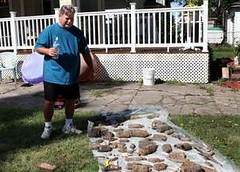 An Illinois woman who set out on a treasure hunt for buried gold coins after finding a cryptic note in an antique rocking chair may have been the victim of a prolific prankster who died more than 30 years ago.
An Illinois woman who set out on a treasure hunt for buried gold coins after finding a cryptic note in an antique rocking chair may have been the victim of a prolific prankster who died more than 30 years ago.
With help of a donated backhoe, Patty Henken recently tore up a vacant lot in Springfield, Ill., where a typewritten note signed by "Chauncey Wolcott" — found in an old chair she bought at auction last November — suggested she would find a chest containing more than $250 in U.S. gold coins.
The dig turned up nothing but bricks and old bottles. Henken planned to return Tuesday with the donated services of a man with ground-penetrating radar meant to detect any buried items, but the treasure note's promise may already be debunked.
An Iowa woman who read news accounts of the hunt said she knows Wolcott's true identity: John "Jay" Slaven, a notorious practical joker and coin collector who often used a typewriter in his pranks.
Slaven used the pen name "Chauncey Wolcott" and lived for decades at the location where the dig took place, until his 1976 death.
To read the complete article, see:
Ill. treasure hunt halted as possible prank
(www.google.com/hostednews/ap/article/
ALeqM5gfdqKcxmLVrbhs_2B2HkyoBJPbRwD9B4GRC00)
The caller apologized, but he has been out of town and hadn't seen the paper since last week or he would have told us sooner. He has the gold coins that are supposedly buried in a lead chest at 1028 N. Fifth Street.
My caller, who did not want to be identified, inherited the coins in 1987. They are secure in a bank in Springfield. He produced a letter from a Florida bank to verify what he said. The bank inventoried the coins, and they correspond exactly to the number and denomination of the coins a note said were buried in a lead chest at 1028 N. Fifth Street.
He has eight $20 gold pieces, six $10, five $5, three $2 1/2 and two $1 gold pieces.
So ends the tale of the no-longer mysterious note and the buried lead chest that wasn't there.
The man who has them is a Springfieldian who was related to Jay and his wife, Frances.
The Slavens had lost both of their children to leukemia at ages 7 and 12. The amateur psychologist in me says Jay's jokes were part of his reaction to such tragedy.
After Jay died in 1976, Frances inherited everything. When Frances died, her estate went to other family members. The coins (valued at $9,000 22 years ago, when gold was cheap) went to my caller.
He and his brother remembered Friday that Jay feuded with his neighbor two houses away at 1026 N. Fifth St. They think perhaps this note about buried treasure was a way to disrupt his neighbor's life. He just didn't know it would take 30 years to find the note and start digging.
Both men remember the chair, a distinctive double rocker, in which Patty Henken found the note. And they have been getting quite a kick out of Jay's final practical joke.
To read the complete article, see:
Bakke: Gold coin treasure found above ground
(www.sj-r.com/homepage/x1991999144/Dave-Bakke-Gold-
coin-treasure-found-above-ground)
DOLLAR BILL GRAFFITI

To read the complete article, see: Juvenile dollar-mod (www.boingboing.net/2009/10/06/juvenile-dollar-mod.html)
FEATURED WEB PAGE: HISTORY OF HOBO NICKELS
This week's Featured Web page is a History of Hobo Nickels by Stephen P. Alpert.
The altering of coins goes back to the late 1700s or earlier. But I will pick up the story in the 1850s and in this section go up to 1912. In this period, the predominant form of coin alteration was the "potty coin," engraved on Seated Liberty design coins (half dime through trade dollar). Also during this time period was the heyday of the love token - a coin (usually silver) was machine- ground smooth on one or both sides. It was then engraved with initials, monograms, names, scenes, etc., often with an ornate border. Hundreds of thousands of coins probably were altered in this manner, with a pin added on the back or they were put on bracelets and necklaces. The love token fad faded out in the early 1900s; love tokens engraved on buffalo nickels are rare.
When the Indian Head or Buffalo nickel was introduced in 1913, it was a natural attraction for coin engravers. The big Indian head was a radical departure from previous (and even subsequent) coin designs. It just begged to be altered. The head was much larger than heads on previous coins, which gave the artists a bigger template to work on, and allowed for more fine details.
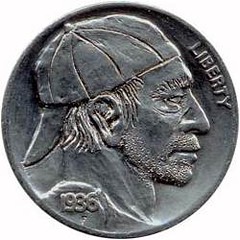
www.hobonickels.org/alpert03.htm
